cctalk Serial Communication Protocol
-
Generic Specification
-
Issue 4.4
Money Controls does not accept liability for any errors or omissions contained
within this document or for any changes made to the standard from one issue to
the next. Money Controls shall not incur any penalties arising out of the
�
adherence to, interpretation of, or reliance on, this standard whether it be now or
in the future.
Public Domain Document
Money Controls - Page 2 of 51 - cctalk Part 1 v4.4
While every effort has been made to ensure the accuracy of this document no liability of any kind is
cctalk Generic Specification -
accepted or implied for any errors or omissions that are contained herein.
�
Revision History
Issue
1.0
3.1
3.2
4.0
4.1
4.2
4.3
4.4
Date
29-04-96
18-05-99
03-02-00
13-06-00
15-05-01
24-05-01
05-10-01
16-04-02
02-01-03
05-08-03
30-09-03
30-10-03
11-11-03
19-03-03
29-03-04
06-04-04
05-07-04
04-08-04
11-01-05
Public Domain Document
Comments
Draft specification
< intervening revision history has been archived >
New section numbering
Miscellaneous clarifications and additional text
9600 baud is the preferred operating speed
Addition of error codes 27 & 28
Addition of ‘Money Controls’ to Table 7
New headers added - see below
Some headers have new data format for Serial Compact Hopper Mk2
Revised default addresses : Table 2 - cctalk Standard Category Strings
Inter-byte delay < 10ms : See ‘Timing Requirements’
Application specific header range is 99 to 20 rather than 99 to 7
Major document restructuring and text revision
New headers to support bill validators
Update to Appendix 10 - Common Country Codes
Stated conformance to ISO 3166-1
Modification to recommended cctalk interface circuit
‘Circuit 1 - cctalk Standard Interface’
Addition of connector type 9 for serial universal hopper
Serial Protocol - Voltage Levels. Allowable ranges now defined.
Help text now included for error and fault codes. See Tables 2 & 3.
ISO 3166 list now fully comprehensive. See Appendix 10.
Default data voltage is +5V. See Appendix 6.
Removal of Controller category ( = address 3 ) from Table 1
Link added to cctalk.org web site
Change to contact FAX number
Route code 255 added to cctalk header 154, ‘Route bill’
Clarification of when address is changed with cctalk header 251,
‘Address change’.
Addition of Appendix 11 - Coin Acceptor Messaging Example
Update of Table 6 - cctalk Standard Manufacturer Strings
NAK is now a recognised reply from cctalk header 142, ‘Finish bill table
upgrade’ to indicate the process failed.
Type 8 connector : note added about polarity
Added Appendix 12 : Italian Flavour Specification Change
Added latest product naming examples
Zener versus Schottky diode clarification in Circuits 1 to 4
Header 163, ‘Test hopper’. Added flag explanation.
Appendix 10 : Common Country Codes : Additional exception
Addition of header 135, ‘Set accept limit’
Added section on BACTA Token Selection
Added new bill event code, ‘Anti-string mechanism faulty’, to Table 7.
Text ‘( or reject or other event ) ’ added to header 162 description.
Circuit 4 - PC Interface. Alternative transistors given.
New section : Discussion of Transitory versus Steady-state Events
Removed from Core Plus : Header 169, Request address mode
Removed from Core Plus : Header 3, Clear comms status variables
Removed from Core Plus : Header 2, Request comms status variables
Calculate ROM checksum : CRC checksum can be calculated with a
fixed seed if required
Request variable set - 2 variables defined for bill validators
Addition of Appendix 14 - Large Packet Exchange
Minor text clarification to Header 2, Request comms status variables
Scope plots added to show cctalk voltage levels and timing
Text changed to ‘( strictly speaking an attempted accept sequence )’ in
Money Controls - Page 3 of 51 - cctalk Part 1 v4.4
While every effort has been made to ensure the accuracy of this document no liability of any kind is
cctalk Generic Specification -
accepted or implied for any errors or omissions that are contained herein.
�
25-01-05
16-05-05
24-08-05
23-12-05
28-12-05
Public Domain Document
header 162 description.
Table 1 : Added Reel equipment at address 30
Table 1 : Added RNG at address 120
Table 3 : Manufacturer-specific fault code can be sent after ‘255’
Table 6 : Added Starpoint Electrics to cctalk User Group
Table 6 : Added Intergrated(sic) Technology Ltd to cctalk User Group
Added 5 commands for an accumulator hopper, headers 130 to 134
Expanded status register in header 163, ‘Test hopper’, to include
accumulator hopper functionality
Specification of rise & fall time added
New connector type 6 part numbers
Re-worked section on BACTA Token Selection
Addition of error code 29 : Accept gate open not closed
Addition of error code 30 : Accept gate closed not open
Addition of fault code 42 : Accept gate failed open
Addition of fault code 43 : Accept gate failed closed
Header 173, ‘Request thermistor reading’ has new Celsius format
Addition of Header 129, ‘Read barcode data’
Addition of bill event code 20, ‘Barcode detected’
Appendix 15 created – Bill Types and Bill Values
Creation of new section ‘cctalk RFC’ in Part 4 / Section 4 of standard.
Proposed changes to the cctalk specification will be placed here.
Money Controls - Page 4 of 51 - cctalk Part 1 v4.4
While every effort has been made to ensure the accuracy of this document no liability of any kind is
cctalk Generic Specification -
accepted or implied for any errors or omissions that are contained herein.
�
Public Domain Document
Command Headers Added Since Version 4.3
Header 134, Dispense hopper value
Header 133, Request hopper polling value
Header 132, Emergency stop value
Header 131, Request hopper coin value
Header 130, Request indexed hopper dispense count
Header 129, Read barcode data
Command Headers Modified Since Version 4.3
The following commands have been removed from the ‘Core Plus’ requirement. They are
now optional.
Header 169, Request address mode
Header 3, Clear comms status variables
Header 2, Request comms status variables
The status registers in the ‘Test hopper’ command, header 163, have been increased by one
byte for accumulator hoppers and some of the reserved flags re-defined. Operation is fully
backwards-compatible with the existing hopper range.
Header 173, Request thermistor reading. Updated return data format.
Money Controls - Page 5 of 51 - cctalk Part 1 v4.4
While every effort has been made to ensure the accuracy of this document no liability of any kind is
cctalk Generic Specification -
accepted or implied for any errors or omissions that are contained herein.
�
Public Domain Document
Part 1 - Contents
1.
HISTORICAL.............................................................................................................................................8
2.
3.1
5.1
3.
4.
5.
6.
2.2.1
6.1
6.2
6.3
6.4
6.5
6.6
6.7
6.8
6.9
6.10
INTRODUCTION.......................................................................................................................................8
2.1
SERIAL VERSUS PARALLEL : A COIN INDUSTRY PERSPECTIVE....................................................8
2.2 WHAT IS CCTALK ?..............................................................................................................................9
Is it a Multi-Master Protocol ? .............................................................................................9
2.3 WHAT ARE ITS CAPABILITIES AND FEATURES ?.........................................................................10
2.4
IS IT DIFFICULT TO IMPLEMENT ? .................................................................................................11
2.5 ARE THERE ANY ROYALTIES TO PAY OR LICENCES TO OBTAIN ? ..........................................11
2.6 A QUICK EXAMPLE OF A CCTALK MESSAGE ................................................................................13
2.7
COMPARISON WITH OTHER SERIAL CONTROL PROTOCOLS......................................................13
SERIAL PROTOCOL - TIMING.......................................................................................................... 13
BAUD RATE.........................................................................................................................................14
SERIAL PROTOCOL - VOLTAGE LEVELS .................................................................................... 14
4.1 OSCILLOSCOPE PLOTS.......................................................................................................................15
THE SERIAL DATA LINE..................................................................................................................... 16
RS485 DRIVERS....................................................................................................................................16
CONNECTOR DETAILS....................................................................................................................... 18
TYPE 1 ( STANDARD INTERFACE, IN-LINE CONNECTOR )...........................................................18
TYPE 2 ( STANDARD INTERFACE, MOLEX CONNECTOR )...........................................................19
TYPE 3 ( LOW POWER INTERFACE )................................................................................................19
TYPE 4 ( EXTENDED INTERFACE, IN-LINE CONNECTOR )...........................................................20
TYPE 5 ( AWP INDUSTRY-STANDARD INTERFACE )....................................................................20
TYPE 6 ( SERIAL HOPPER INTERFACE ) ..........................................................................................21
TYPE 7 ( STANDARD INTERFACE, JST CONNECTOR ) ..................................................................21
TYPE 8 ( SERIAL HOPPER INTERFACE, VERSION 2 )......................................................................22
TYPE 9 ( UNIVERSAL HOPPER INTERFACE )...................................................................................22
CONNECTOR WIRING COLOURS................................................................................................24
7. MESSAGE STRUCTURE....................................................................................................................... 25
STANDARD MESSAGE PACKETS, SIMPLE CHECKSUM..................................................................25
7.1
STANDARD MESSAGE PACKET, CRC CHECKSUM .........................................................................26
7.2
ENCRYPTED MESSAGE PACKET, CRC CHECKSUM........................................................................26
7.3
7.4
PROTOCOL LAYERING.......................................................................................................................26
7.5 DESTINATION ADDRESS....................................................................................................................27
The Broadcast Message....................................................................................................... 27
7.6 NO. OF DATA BYTES..........................................................................................................................27
Long Transfers....................................................................................................................... 28
7.7
SOURCE ADDRESS...............................................................................................................................28
7.8 HEADER................................................................................................................................................28
7.9 DATA....................................................................................................................................................29
SIMPLE CHECKSUM .....................................................................................................................29
7.10
CRC CHECKSUM ...........................................................................................................................29
7.11
A Little Checksum Theory................................................................................................... 29
ANATOMY OF AN EXAMPLE MESSAGE SEQUENCE ...............................................................31
THE ACKNOWLEDGE MESSAGE...................................................................................................... 32
THE NAK MESSAGE...........................................................................................................................32
THE BUSY MESSAGE..........................................................................................................................32
COMMANDS THAT RETURN ASCII STRINGS ............................................................................. 33
7.11.1
7.5.1
7.6.1
8.1
8.2
8.
9.
7.12
Money Controls - Page 6 of 51 - cctalk Part 1 v4.4
While every effort has been made to ensure the accuracy of this document no liability of any kind is
cctalk Generic Specification -
accepted or implied for any errors or omissions that are contained herein.
�
Public Domain Document
9.1
FIXED LENGTH STRINGS ...................................................................................................................33
IMPLEMENTATION DETAILS............................................................................................................ 33
10.
11.1
11.2
11. TIMING REQUIREMENTS.................................................................................................................... 35
BETWEEN BYTES.........................................................................................................................35
BETWEEN COMMAND AND REPLY ...........................................................................................35
12. ACTION ON ERROR............................................................................................................................. 36
RETRANSMISSION.........................................................................................................................36
13. UNRECOGNISED HEADERS ............................................................................................................... 36
12.1
14.
PRACTICAL LIMITATIONS IN VERY LOW COST SLAVE DEVICES..................................... 36
15.1
15. COMMAND SET..................................................................................................................................... 38
COMMAND EXPANSION...............................................................................................................38
Expansion Headers .............................................................................................................. 38
Context Switching................................................................................................................ 38
IMPLEMENTATION LEVEL .........................................................................................................39
IMPLEMENTING CCTALK ON A NEW PRODUCT....................................................................... 39
15.1.1
15.1.2
15.2
16.
17.
IMPLEMENTATION STANDARDS.................................................................................................... 40
20.1
19.1
18.1
18. COIN ACCEPTORS - CREDIT POLLING ALGORITHM.............................................................. 40
THE CREDIT POLL WATCHDOG................................................................................................40
19. WRITING GENERIC HOST SOFTWARE APPLICATIONS ......................................................... 41
DESIGNING A CCTALK API .........................................................................................................41
20. MULTI-DROP CONSIDERATIONS ................................................................................................... 42
PRACTICAL LIMITATIONS OF MULTI-DROP NETWORKS.....................................................43
20.1.1 Maximum Number of Network Devices............................................................................. 43
20.1.1.1 Logical Addressing..............................................................................................................43
20.1.1.2 Electrical Loading................................................................................................................43
20.1.1.3 Address Randomisation......................................................................................................43
MDCES - MULTI-DROP COMMAND EXTENSION SET ...........................................................44
Address Poll, Header 253 ................................................................................................... 44
Address Clash, Header 252 ................................................................................................ 45
Address Change, Header 251............................................................................................. 46
Address Random, Header 250............................................................................................ 46
21. DISCUSSION OF TRANSITORY VERSUS STEADY-STATE EVENTS ..................................... 48
20.2.1
20.2.2
20.2.3
20.2.4
20.2
22. CONTACT INFORMATION................................................................................................................. 51
Money Controls - Page 7 of 51 - cctalk Part 1 v4.4
While every effort has been made to ensure the accuracy of this document no liability of any kind is
cctalk Generic Specification -
accepted or implied for any errors or omissions that are contained herein.
�
Public Domain Document
1. Historical
Jun 87 : Coin Controls Ltd abandons I2C development on future products in favour of the
RS232 protocol.
Apr 96 : ‘cctalk’ specification created after much consultation within the industry.
Aug 98 : A meeting of coin mechanism manufacturers in Tamworth, England agrees on a
common connector supporting both cctalk and Mars HI2 for AWP machines. The data
format was standardised at +12V, 9600 baud.
Jun 99 : Coin Controls Ltd sets up a cctalk User Group to promote cctalk within the
industry and to provide a formal mechanism for both obtaining feedback from users and for
expanding the specification into new areas.
Jun 00 : Protocol proving successful in many diverse applications. Specification updated to
include an ultra-secure compact hopper and a new range of cctalk bill validators
Aug 00 : Meeting in Burton-on-Trent, England to discuss the future of cctalk in relation to
bill validators. Encryption and CRC checksums discussed.
Nov 00 : Encryption and CRC checksums added into the protocol for BNV’s. BNV
simulation software made available to manufacturers.
Jan 04 : Italy adopts cctalk throughout their AWP platforms and a variety of products are
put through homologation. Hoppers are used ‘unencrypted’.
Dec 05 : Money Controls successfully tests cctalk running at 1Mbps over a USB virtual
COM port link leading to exciting new areas of product development.
Introduction
2.
2.1 Serial versus Parallel : A Coin Industry Perspective
Both serial and parallel interface techniques have advantages and disadvantages. Parallel
interfaces are fast and in some applications provide the simplest way of transferring
information. However, cable harnessing costs can reach a significant proportion of the
original equipment costs as the number of data lines increase. Problems with crimp
connectors and dry solder joints can give reliability issues when a large number of wires are
used to send data. Serial interfaces on the other hand reduce cabling costs to a minimum and
often enable extra features ( such as self-testing and expansion ) to be incorporated into the
product with very little overhead. Serial interfaces also provide a simple and efficient way of
connecting two or more devices together in situations which would be totally impractical
with a parallel interface. This reduces cabling costs even further in applications which require
a number of devices to be connected to a single host controller.
The cash handling industry now embraces many different aspects of technology from coin
and token acceptors through bill validators and magnetic / smart card readers to intelligent
payouts and changers. A way of connecting all these different types of peripherals in a
simple and consistent manner is a stated aim of many manufacturers and a serial bus is the
obvious solution.
Money Controls - Page 8 of 51 - cctalk Part 1 v4.4
While every effort has been made to ensure the accuracy of this document no liability of any kind is
cctalk Generic Specification -
accepted or implied for any errors or omissions that are contained herein.
�
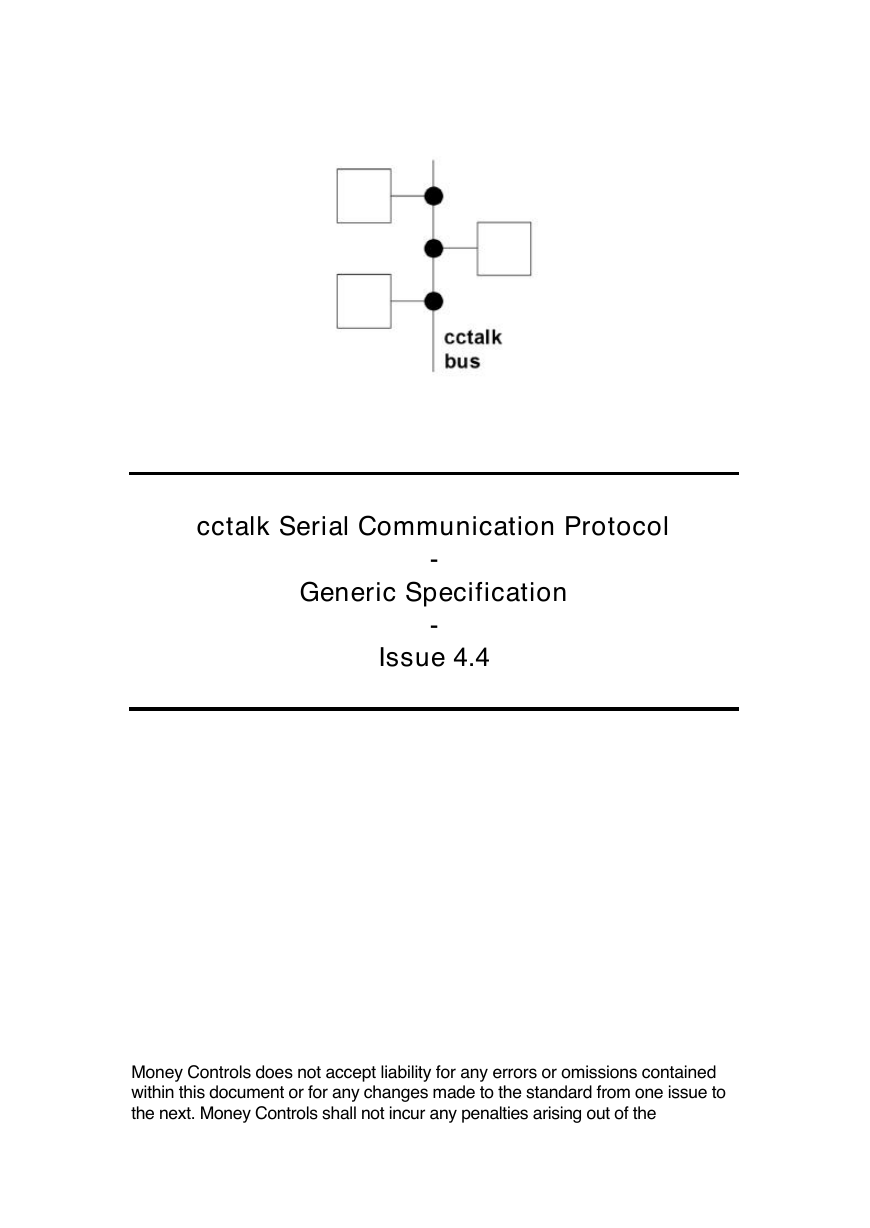
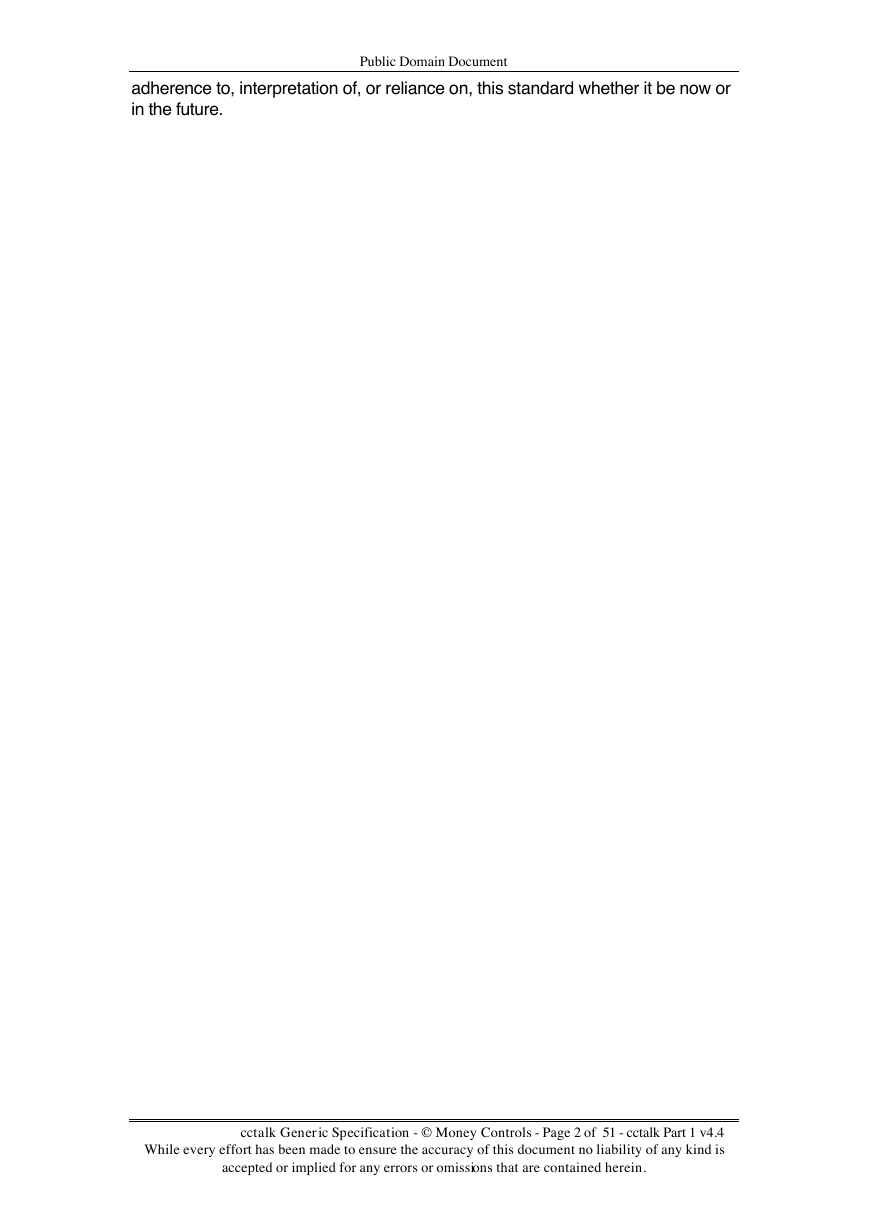
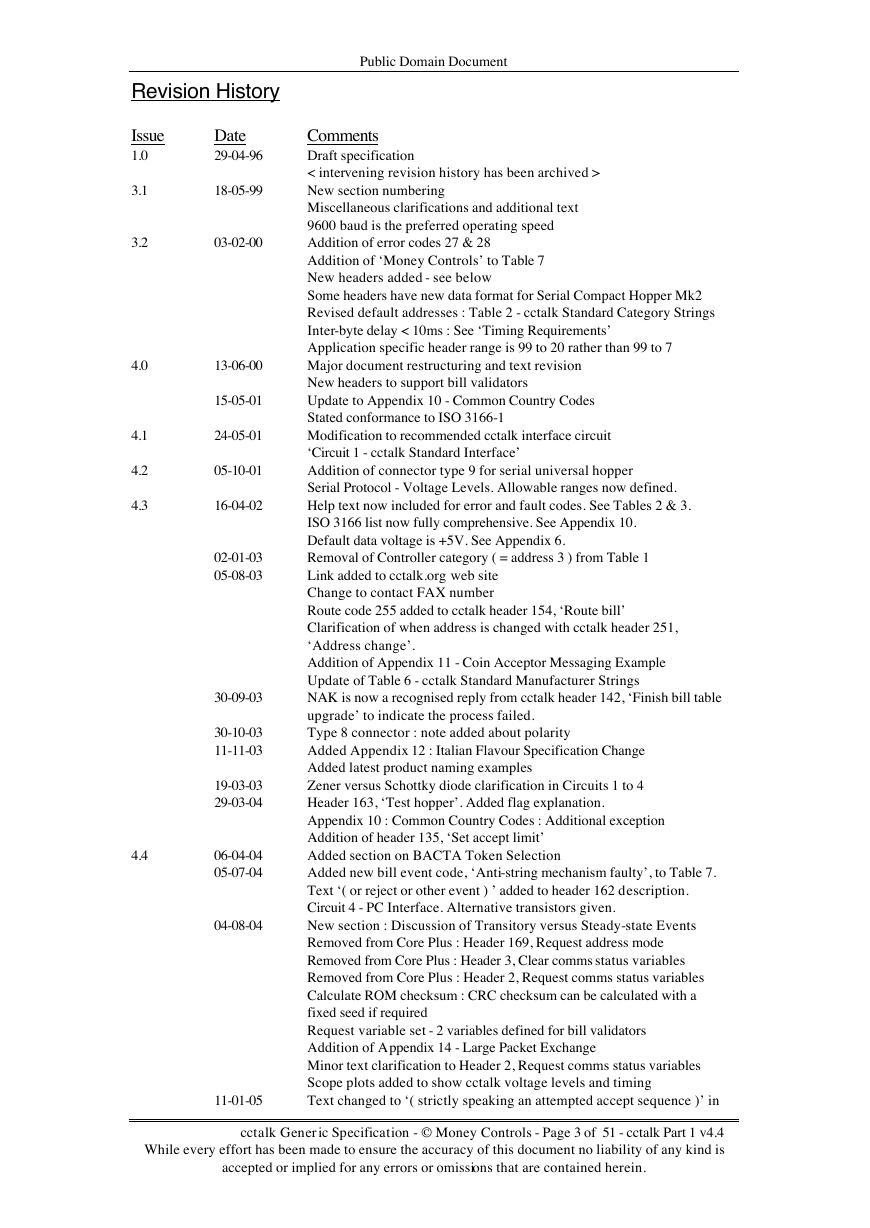

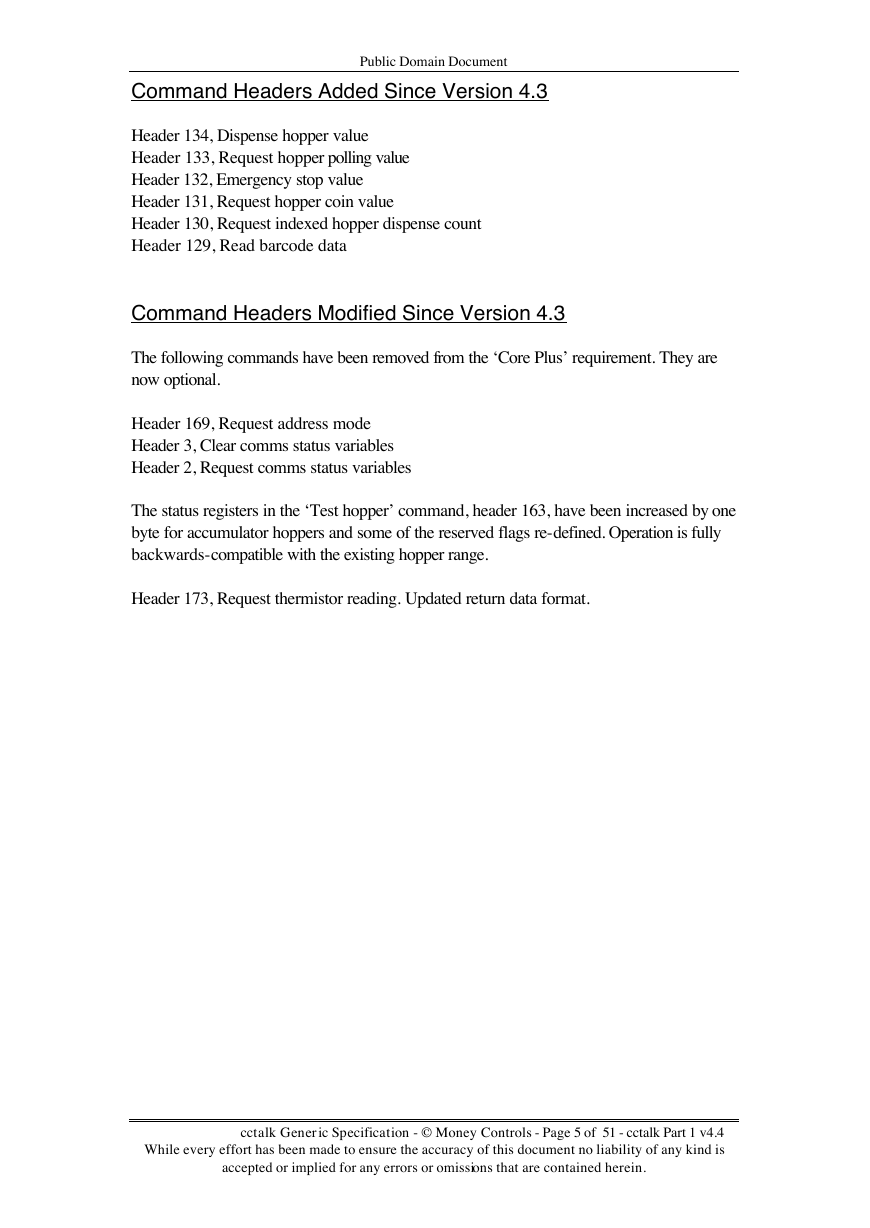
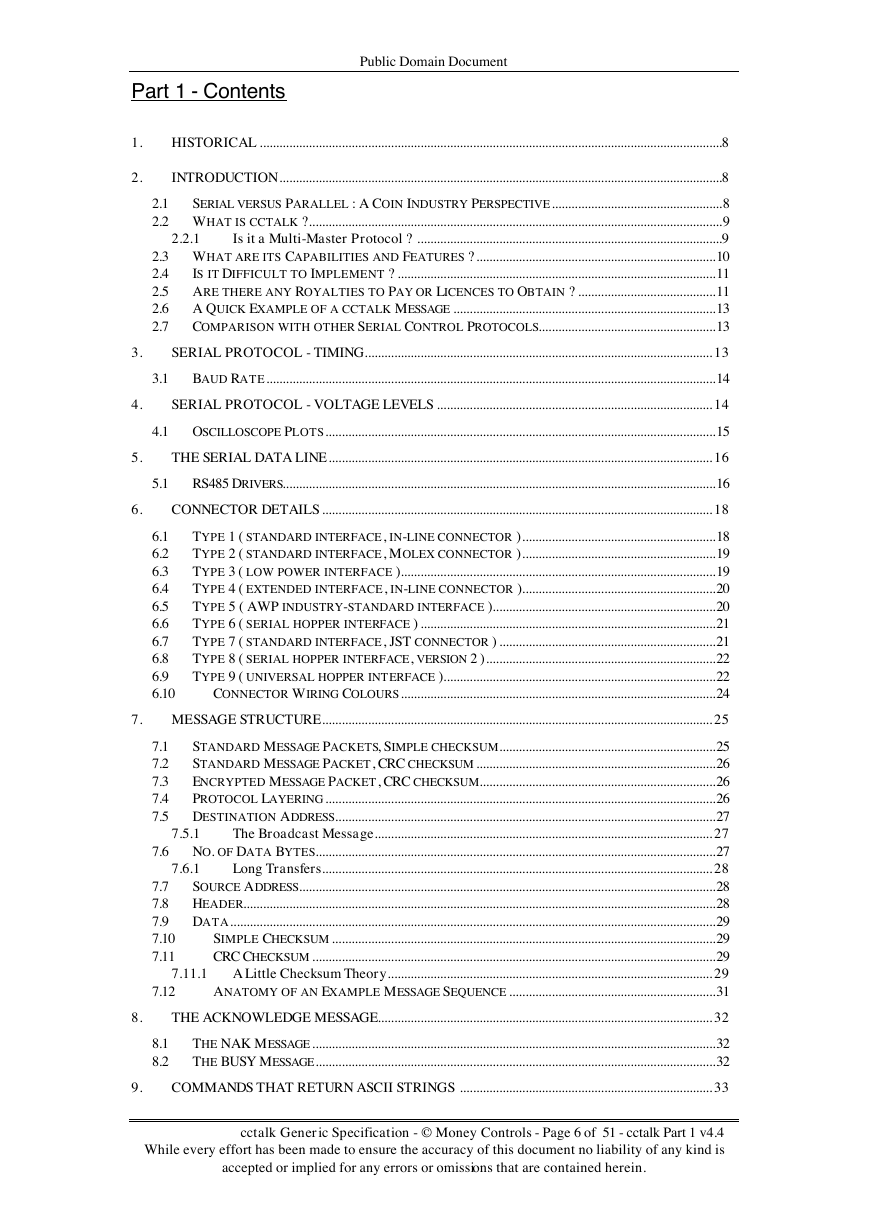
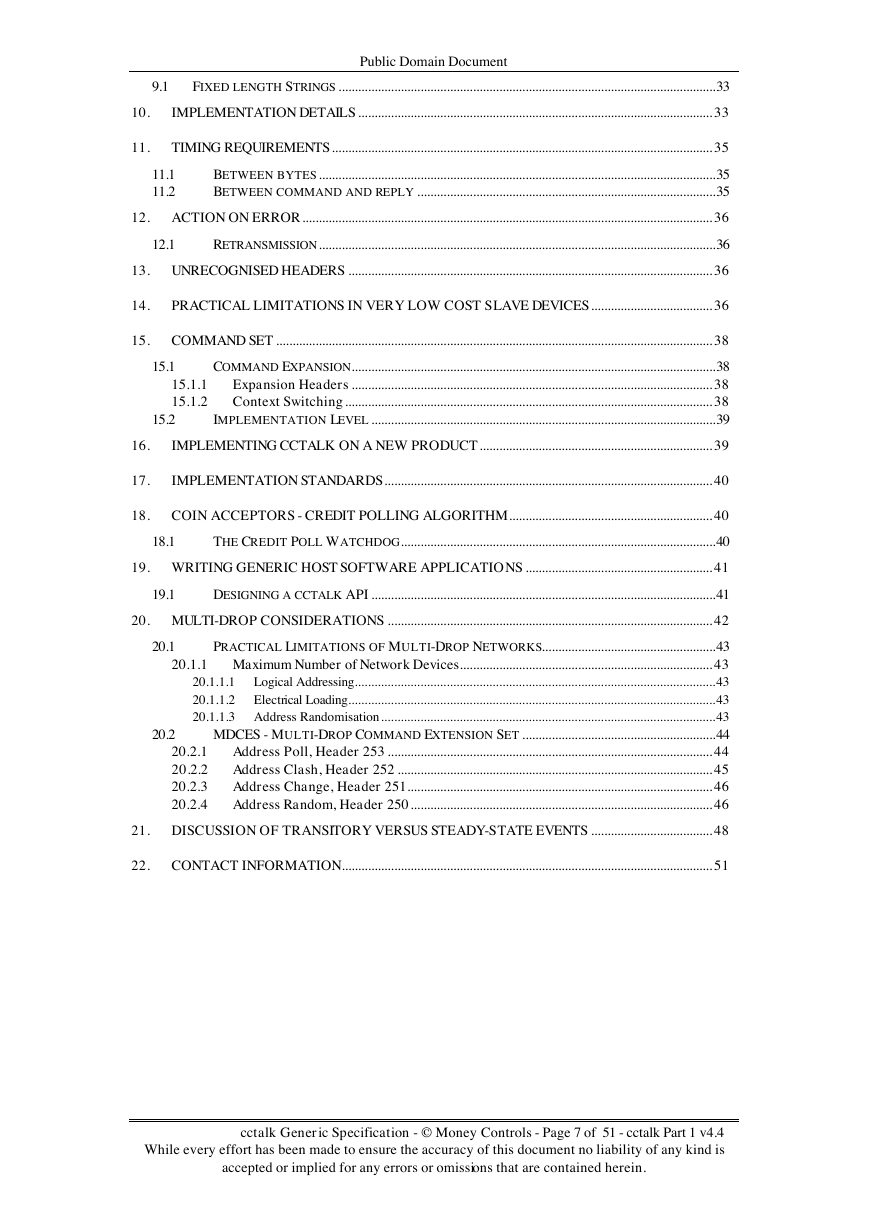









 2023年江西萍乡中考道德与法治真题及答案.doc
2023年江西萍乡中考道德与法治真题及答案.doc 2012年重庆南川中考生物真题及答案.doc
2012年重庆南川中考生物真题及答案.doc 2013年江西师范大学地理学综合及文艺理论基础考研真题.doc
2013年江西师范大学地理学综合及文艺理论基础考研真题.doc 2020年四川甘孜小升初语文真题及答案I卷.doc
2020年四川甘孜小升初语文真题及答案I卷.doc 2020年注册岩土工程师专业基础考试真题及答案.doc
2020年注册岩土工程师专业基础考试真题及答案.doc 2023-2024学年福建省厦门市九年级上学期数学月考试题及答案.doc
2023-2024学年福建省厦门市九年级上学期数学月考试题及答案.doc 2021-2022学年辽宁省沈阳市大东区九年级上学期语文期末试题及答案.doc
2021-2022学年辽宁省沈阳市大东区九年级上学期语文期末试题及答案.doc 2022-2023学年北京东城区初三第一学期物理期末试卷及答案.doc
2022-2023学年北京东城区初三第一学期物理期末试卷及答案.doc 2018上半年江西教师资格初中地理学科知识与教学能力真题及答案.doc
2018上半年江西教师资格初中地理学科知识与教学能力真题及答案.doc 2012年河北国家公务员申论考试真题及答案-省级.doc
2012年河北国家公务员申论考试真题及答案-省级.doc 2020-2021学年江苏省扬州市江都区邵樊片九年级上学期数学第一次质量检测试题及答案.doc
2020-2021学年江苏省扬州市江都区邵樊片九年级上学期数学第一次质量检测试题及答案.doc 2022下半年黑龙江教师资格证中学综合素质真题及答案.doc
2022下半年黑龙江教师资格证中学综合素质真题及答案.doc